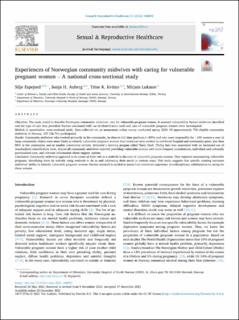| dc.contributor.author | Espejord, Silje | |
| dc.contributor.author | Auberg, Sonja Henriksen | |
| dc.contributor.author | Kvitno, Trine Kristoffersen | |
| dc.contributor.author | Lukasse, Mirjam | |
| dc.date.accessioned | 2023-04-28T09:03:37Z | |
| dc.date.available | 2023-04-28T09:03:37Z | |
| dc.date.created | 2022-01-27T08:26:40Z | |
| dc.date.issued | 2022 | |
| dc.identifier.citation | Espejord, S., Auberg, S. H., Kvitno, T. K. & Lukasse, M. (2022). Experiences of Norwegian community midwives with caring for vulnerable pregnant women – A national cross-sectional study. Sexual & Reproductive Healthcare, 31, Artikkel 100693. | en_US |
| dc.identifier.issn | 1877-5756 | |
| dc.identifier.uri | https://hdl.handle.net/11250/3065448 | |
| dc.description.abstract | Objectives: The study aimed to describe Norwegian community midwives’ care for vulnerable pregnant women. It assessed vulnerability factors midwives identified and the type of care they provided. Factors associated with use of identification tools and care of vulnerable pregnant women were investigated.
Method: A quantitative, cross-sectional study. Data collected via an anonymous online survey conducted spring 2020. Of approximately 700 eligible community midwives in Norway, 257 (36.7%) participated.
Results: Community midwives who worked primarily in the community, in close to full-time positions (>80%) and who were responsible for >100 women a year in large community clinics were more likely to identify vulnerable pregnant women than midwives who worked in combined hospital and community posts, less than 80% in the community and at smaller community centres. Attended a training progam called ‘Early Start’ (Tidlig Inn) was associated with an increased use of standardized identification tools. Almost all community midwives reported providing vulnerable women with more frequent consultations, individual and culturally personalized care, and relevant information about support options.
Conclusion: Community midwives appeared to be aware of their role as a midwife in the care of vulnerable pregnant women. They reported encountering vulnerable pregnant, identifying them by actively using methods to do so and addressing their needs in various ways. This study suggests that specific training increases midwives‘ ability to identify vulnerable pregnant women. Further research is needed to assess how midwives experience interdisciplinary collaboration in caring for these women. | en_US |
| dc.language.iso | eng | en_US |
| dc.rights | Navngivelse 4.0 Internasjonal | * |
| dc.rights.uri | http://creativecommons.org/licenses/by/4.0/deed.no | * |
| dc.title | Experiences of Norwegian community midwives with caring for vulnerable pregnant women - A national cross-sectional study | en_US |
| dc.type | Peer reviewed | en_US |
| dc.type | Journal article | en_US |
| dc.description.version | publishedVersion | en_US |
| dc.rights.holder | © 2021 The Authors. | en_US |
| dc.source.pagenumber | 1-7 | en_US |
| dc.source.volume | 31 | en_US |
| dc.source.journal | Sexual & Reproductive HealthCare | en_US |
| dc.identifier.doi | https://doi.org/10.1016/j.srhc.2021.100693 | |
| dc.identifier.cristin | 1990920 | |
| dc.source.articlenumber | 100693 | en_US |
| cristin.ispublished | true | |
| cristin.fulltext | original | |
| cristin.qualitycode | 1 | |

